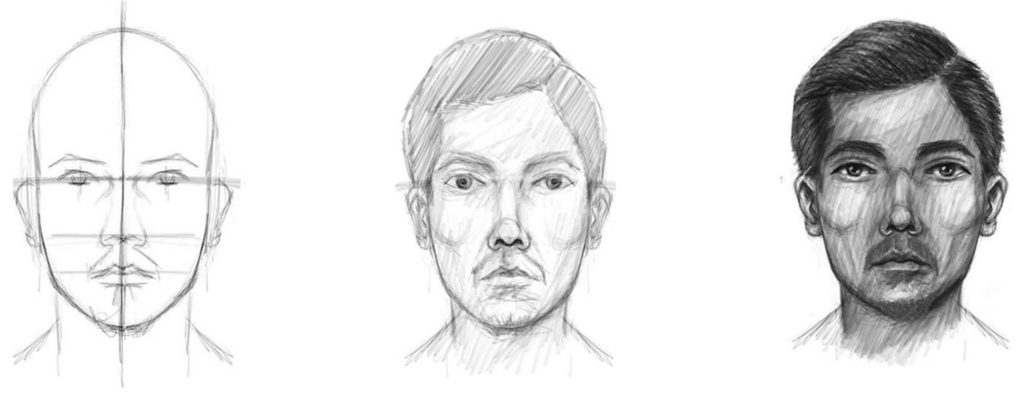Paid
Suggested Materials for Forensic Artists
Suggested Materials for Forensic Artists answers the questions that curious students ask about forensic art and the materials they’ll need to get started. If you watch the news, you’ll see facial composites in several different drawing styles, in color, in black and white, using all sorts of media, including software-driven solutions. Students will be introduced to some basic tools used by forensic artists, including advanced tools that students can use as they move further along in their forensic art journey. Some of these tools some will have already and some they never considered. After completing this course, the value of curating these materials, knowing how to use them, and having them at the ready will become more apparent as you discover how forensic art is truly – a different kind of art.
Why & When to Create a Facial Composite
Investigators have many options used to identify unknown suspects. One is facial composites. Many times investigators call upon forensic artists as a means to check a box on an investigative checklist. Although investigators understand the value of facial composites, they don’t necessarily understand under what circumstances they should do one, or when to introduce the facial composite into their investigation. This further includes limitations on their eyewitness.
As an investigative resource, the forensic artist, should view themselves as a case consultant. Although it can be a slippery slope, (The forensic artist does not want to be seen as trying to tell investigators how to run their case.) there may be some things the forensic artist can suggest that investigators might not have considered.
In this course, students will examine why the forensic artist should create and facial composite and when it’s best to do so. This also includes eyewitness limitations that greatly affect the why and the when.
Our course, WHY & WHEN to Create a Facial Composite, is perfect for:
*Anyone who wants to learn the circumstances of WHY a facial composite should be done.
*Anyone wanting to increase their knowledge about using facial composites as an investigative tool.
*Forensic students who want to learn the strength & limitations of a facial composite as a way to complement other evidence they are evaluating.
*Law Enforcement/Forensic professionals who want to learn WHEN it’s a good decision to create a facial composite.
*Forensic Artists who want to review & reinforce their skills
*Material is suitable for beginners & those with previous experience
Those attending WHY & WHEN to Create a Facial Composite will view a narrated presentation and audio lecture that demonstrates and supports WHY & WHEN investigators should consider using a facial composite during an investigation. Handout materials are also provided.
Course instruction will include:
*WHY create a facial composite
*WHEN to create a facial composite
*Human and environmental elements to consider
*Thoughts on how to fill the role of case consultant
*Quiz
Forensic Art in Criminal Investigations
Investigators often call upon forensic artists to assist them during criminal cases. Especially, when the only available evidence is an eyewitness description.
To increase their opportunity for success, the forensic artist must carefully evaluate and interview the eyewitness to create the ‘perfect’ image from their ‘imperfect’ memory.
Sound difficult? Sometimes it is. But, it can be done. The question is – how?
In this course, you’ll discover how forensic artists put their skills to work. Students will examine the facts behind an actual case solved by a composite sketch.
This mini-course is perfect for:
*Anyone who wants to learn how a forensic artist does his/her job
*Anyone wanting to increase their knowledge about composite sketches
*Forensic students who want to learn the process it takes to create a composite sketch,
*Forensic professionals who want to learn a new skill
*Forensic Artists who want to review & reinforce their skills
*Material is suitable for beginners & those with previous experience
Those attending Forensic Art in Criminal Investigations will view a series of presentations that demonstrate the value of using a composite sketch during criminal investigations. This includes the steps involved in conducting an interview and creating a composite sketch.
As an introductory course, instruction will include:
*Case Analysis + Update
*Steps included in the Investigative Process
*Steps in the Development of the Composite Sketch
*The Completed Suspect Sketch
* An Analysis & Comparison of the Sketch via Split Screen Comparison
*Quiz
How to Become a Forensic Artist

For nearly four decades, Michael W. Streed has provided signature images for some of America’s most notorious murders, rapes, and kidnappings, including the kidnapping and murder of five-year-old Samantha Runnion, the Orange County, CA Fortune Teller Murders & the Baton Rouge Serial Killer, just to name a few.
Also known as The SketchCop®, Michael has fought crime, coast-to-coast, from Los Angeles to Baltimore, Salt Lake City to Baton Rouge. Along the way, he has papered the walls of police squad rooms with sketches of their city’s most dangerous criminals.
But what does it take to become a forensic artist?
This free downloadable ‘tip sheet’ outlines 10 actionable steps, recommended by The SketchCop® himself, so you can start preparing for a career as a forensic artist.
This ‘course’ includes:
* Downloadable action tip list
* Recommended supplemental reading list
